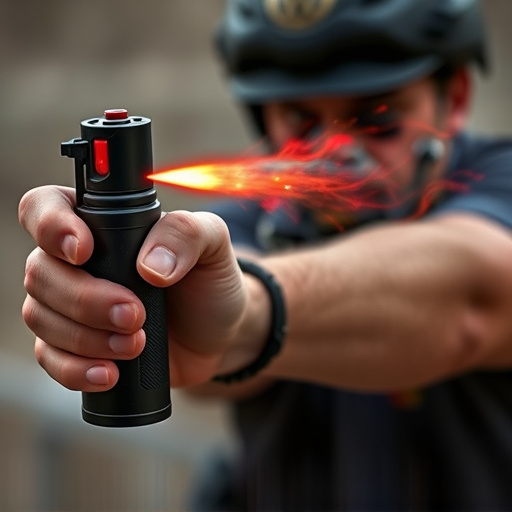Pets exposed to pepper spray require immediate action, including rinsing with water and potential veterinary care for severe reactions. Anti-inflammatory medications may be prescribed. Owners should proactively prepare for exposure risks during chaotic events. Quick treatment is vital to managing symptoms like eye irritation, skin inflammation, or respiratory distress in pets affected by inflammatory sprays used in riot control.
“In recent years, inflammatory sprays, particularly pepper spray, have gained prominence as tools for riot control. While effective for human crowd control, their impact on pets is a growing concern. This article delves into the world of pepper spray and its effects on animals, offering insights into immediate post-exposure care and available treatment options. Understanding these aspects is crucial in ensuring the well-being of pets potentially exposed during chaotic situations. Learn how to navigate this complex issue and provide the best care for your furry companions after they’ve been treated with inflammatory sprays.”
- Understanding Pepper Spray and Its Effects on Pets
- Immediate Steps to Take After Pet Exposure
- The Role of Inflammatory Sprays in Riot Control
- Effective Treatment Options for Pepper Spray Exposure on Pets
Understanding Pepper Spray and Its Effects on Pets
Pepper spray, a common tool in riot control and self-defense, is designed to temporarily incapacitate individuals by causing irritation and pain through its capsaicin content. However, when pets are exposed to this irritant, it can lead to significant discomfort and potential health issues. The effects of pepper spray on animals can vary greatly depending on the species, size, and sensitivity of the pet, as well as the concentration of capsaicin in the spray.
Treating pets exposed to pepper spray is a priority for animal welfare. Mild symptoms may include coughing, eye watering, and difficulty breathing. More severe reactions could result in pancreatitis, respiratory distress, or even heart arrhythmias. Veterinarians recommend immediate washing of the eyes and skin with large amounts of water to dilute the capsaicin. In some cases, antihistamines and corticosteroids might be administered to alleviate inflammation and reduce discomfort. It’s crucial for pet owners to be aware of the potential risks and have a plan in place should their pets come into contact with inflammatory sprays during riots or other chaotic situations.
Immediate Steps to Take After Pet Exposure
If your pet has been exposed to pepper spray during a riot control situation, immediate action is crucial. The first step is to remove any contaminated clothing or gear from the animal as quickly as possible to prevent further irritation or absorption of the chemical. Rinse the affected areas gently with warm water; this can help dilute and wash away residual spray.
Seek veterinary assistance promptly. Treating pets exposed to pepper spray involves careful monitoring for respiratory distress, eye irritation, or skin inflammation. A veterinarian may administer fluids, prescribe anti-inflammatory medications, or recommend specialized treatments based on the severity of the exposure. It’s essential to follow their advice and provide any required aftercare to ensure your pet’s well-being and recovery from this unusual event.
The Role of Inflammatory Sprays in Riot Control
Inflammatory sprays, often known as pepper spray or capsaicin-based agents, play a significant role in riot control and crowd management. These non-lethal weapons are designed to cause temporary disorientation and pain, enabling law enforcement to de-escalate volatile situations and maintain public safety. When deployed during riots or civil unrest, inflammatory sprays can help control large crowds, allowing for easier navigation and access to affected areas.
In addition to their use in riot control, it’s important to consider the potential impact on pets exposed to these substances. Treating pets that have been exposed to pepper spray requires immediate action, including thorough rinsing with water and seeking veterinary care if symptoms persist or severe reactions occur. The effects of inflammatory sprays can be especially detrimental to animals due to their sensitive respiratory systems, so prompt and appropriate treatment is crucial.
Effective Treatment Options for Pepper Spray Exposure on Pets
Pets, like humans, can unfortunately be affected by pepper spray during riot control or other situations where it’s used. If your pet has been exposed to pepper spray, immediate action is crucial for their comfort and safety. The first step is to remove any visible spray residue from their fur using a damp cloth. Avoid using water as this may temporarily bind the chemical agents. Once cleaned, gently wash them with a mild, tear-free pet shampoo to help neutralize any remaining chemicals.
After washing, rinse thoroughly with warm water and dry them gently. If irritation persists or breathing difficulties occur, seek immediate veterinary care. It’s important to note that while treating pets exposed to pepper spray is possible, prevention is key. Keeping pets away from areas where riot control measures are in place is ideal to avoid any adverse effects.
Inflammatory sprays, including pepper spray, have seen increased usage in riot control, raising concerns about their impact on pets. When animals are exposed, it’s crucial to take immediate action. Effective treatment involves soothing the affected area, seeking veterinary care, and using specialized washes or wipes designed for decontaminating pets from such substances. By understanding the effects and implementing prompt measures, we can better support our furry companions after exposure to inflammatory sprays during civil unrest. Treating pets exposed to pepper spray requires a swift and targeted approach to ensure their comfort and well-being.
